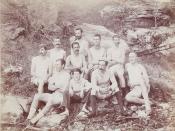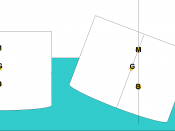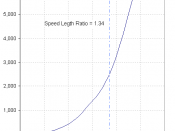Physics Coursework
Physics of rowing
Propulsion
A boat accelerates through the action/reaction principle (Newton's third law). You move water one way with your oar; the boat moves the other way. The momentum (=mass*velocity) you put into the water will be equal and opposite to the momentum acquired by the boat.
Consider a boat before and after a stroke.
PIC 1
Before the stroke, total momentum p = 0, since everything is at rest.
After the stroke, total momentum: p = mbvb áV mwvw = 0 because the total momentum can't change (Newton's second law).
During the normal stroke (i.e. with the boat already moving) it is less obvious that water is moved backwards in order to keep the boat moving forwards, since the blades appear to 'lock' in where they are placed, but if you look at the puddles when the blades are extracted it's clear that water is moved. There has to be some slippage in order to accelerate the boat, although, from energy considerations, this should be made as small as possible.
So what about if you push off the bottom of the river, or a series of poles planted along the riverbank, rather than the water? Well, in that case the whole planet moves backwards instead, and some slippage still occurs.
Resistance
Bodies moving in liquid slow down due to resistive forces known as drag. This actually represents the transfer of momentum from the body to the fluid: the surrounding fluid speeds up as the body slows down, so total momentum still remains constant. For boats, there are various types of drag:
"h Skin Drag, due to friction between the hull entraining water along with the hull
"h Form Drag, due to turbulence created by the passage of the hull
"h Wave Drag, due to energy lost in...


